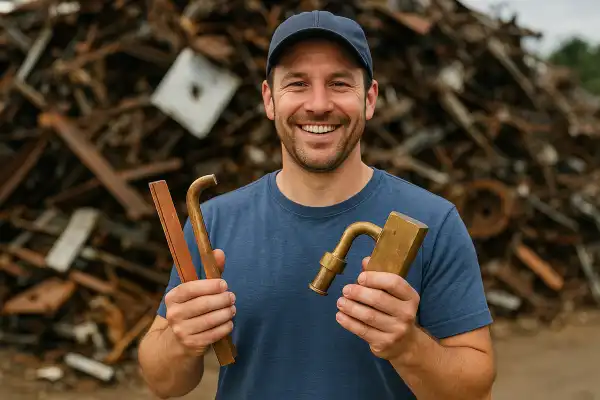How to sort scrap metal for recycling? remains one of the most frequent questions I encounter from both seasoned collectors and newcomers entering the recycling industry. The complexity of metal identification, combined with evolving market demands and technological advances, creates confusion even among experienced handlers.
During my early years transitioning from mechanical engineering to sustainability consulting, I witnessed firsthand how improper sorting cost a mid-sized manufacturing facility nearly $40,000 in lost revenue over six months. Their mixed-metal approach meant accepting the lowest-grade pricing for valuable specialty alloys—a mistake that sparked my deeper dive into systematic sorting methodologies.
How to sort scrap metal for recycling?
Sorting scrap metal for recycling involves systematically separating metals by type, grade, and composition using techniques ranging from basic magnetic testing to advanced XRF analysis. Proper sorting maximizes value by ensuring each metal type receives appropriate pricing while preventing contamination that reduces overall material quality.

The fundamentals of effective scrap metal sorting begin with understanding the two primary categories: ferrous and non-ferrous metals. This classification system forms the backbone of all professional sorting operations and directly impacts your potential returns.
Essential equipment for sorting operations
A well-equipped sorting operation requires several key tools: handheld magnets for ferrous/non-ferrous separation, labeled containers or bins for different metal types, personal protective equipment including cut-resistant gloves and safety glasses, and measuring tools for weight estimation.
Setting up labeled bins from the start prevents the time-consuming task of re-sorting large mixed piles later. Professional operations typically maintain separate containers for aluminum, copper, brass, stainless steel, carbon steel, and specialty alloys.
Advanced sorting facilities increasingly employ handheld XRF (X-ray fluorescence) analyzers for precise alloy identification, with modern units capable of identifying specific grades in seconds. These devices have become more affordable and accessible, with entry-level models available for serious recyclers.
The magnetic separation method
Magnetic testing provides the most fundamental sorting technique, quickly distinguishing ferrous metals (containing iron) from non-ferrous varieties. Ferrous metals like iron and steel are attracted to magnets, while non-ferrous metals such as aluminum, copper, and brass show no magnetic attraction.
This initial separation step allows for immediate value assessment, as non-ferrous metals generally command higher prices due to their rarity and specialized applications. Professional sorters often use powerful neodymium magnets or magnetic separators to handle larger volumes efficiently.
Steel and iron are frequently sold together at recycling facilities, though some yards may offer slightly different pricing for clean steel versus mixed iron scrap.
Visual identification techniques
Experienced sorters develop keen visual recognition skills for different metal types. Copper typically displays a reddish color when clean, though weathered copper may appear dark brown or green due to oxidation. Brass exhibits a yellowish appearance, while aluminum remains silver-colored and notably lightweight compared to steel.
Lead stands out due to its exceptional weight-to-size ratio, while stainless steel maintains its appearance without rust formation, distinguishing it from carbon steel varieties. These visual cues, combined with weight assessment, enable rapid preliminary sorting.
Advanced identification methods
Modern XRF analyzers can identify specific alloy grades and compositions within seconds, providing laboratory-quality analysis in handheld devices. These tools have revolutionized precision sorting, especially for high-value specialty alloys where grade identification significantly impacts pricing.
The industry increasingly adopts AI-powered sorting systems and automated technologies to improve efficiency and accuracy. Large-scale operations benefit from sensor-based sorting equipment that can process material flows continuously.
Some facilities employ PMI (Positive Material Identification) testing using specialized equipment to ensure accurate alloy classification for critical applications.
Safety protocols and protective equipment
Scrap metal handling requires comprehensive personal protective equipment including cut-resistant gloves, safety glasses, steel-toed boots, and hard hats. OSHA recommends additional protection such as respirators and thick clothing when handling materials that may contain hazardous substances.
Workers face multiple hazard categories: mechanical risks from sharp edges and heavy loads, chemical exposure from hazardous substances, and potential radiological dangers from certain industrial materials. Common injuries include sprains, strains, cuts, lacerations, and punctures, making proper lifting techniques and ergonomic practices essential.
Maintaining clean work areas prevents accidents and improves sorting efficiency. First aid kits should remain easily accessible and well-stocked with appropriate medical supplies.
Cleaning and preparation standards
Clean metal consistently commands higher prices than dirty or contaminated material, making thorough preparation a crucial profit factor. Removing rust, paint, insulation, and other attachments improves both appearance and purity ratings.
Copper sorting requires particular attention to separation from other materials, as even small amounts of contamination can significantly reduce value. Professional operations often maintain separate grades for #1 copper (clean), #2 copper (oxidized), and insulated copper wire.
Stainless steel grades command premium pricing when properly identified and cleaned. Different stainless steel alloys have varying nickel content, affecting their market value significantly.
Market considerations and pricing factors
The 2024-2025 scrap metal market shows robust growth driven by sustainability initiatives, electric vehicle production, and infrastructure development. AI-powered sorting systems and technological advancements continue enhancing recycling efficiency across the industry.
Copper remains among the most valuable recyclable metals due to its conductivity properties and widespread industrial applications. Current market volatility makes real-time pricing awareness essential for maximizing returns.
Understanding regional market variations helps optimize selling strategies. Different recycling facilities may offer varying prices for identical materials based on their processing capabilities and end-market relationships.
Conclusion
Last month, while consulting for a small automotive parts manufacturer, I implemented a systematic sorting protocol that increased their scrap revenue by 35% within eight weeks. The key breakthrough came when we identified several tons of mixed stainless steel grades that had been selling as generic scrap metal. Using handheld XRF analysis, we separated 316L surgical steel components worth nearly three times the mixed-metal rate. This experience reinforced my conviction that methodical sorting approaches, combined with proper identification tools and safety protocols, transform scrap handling from a disposal necessity into a genuine profit center for any operation.
